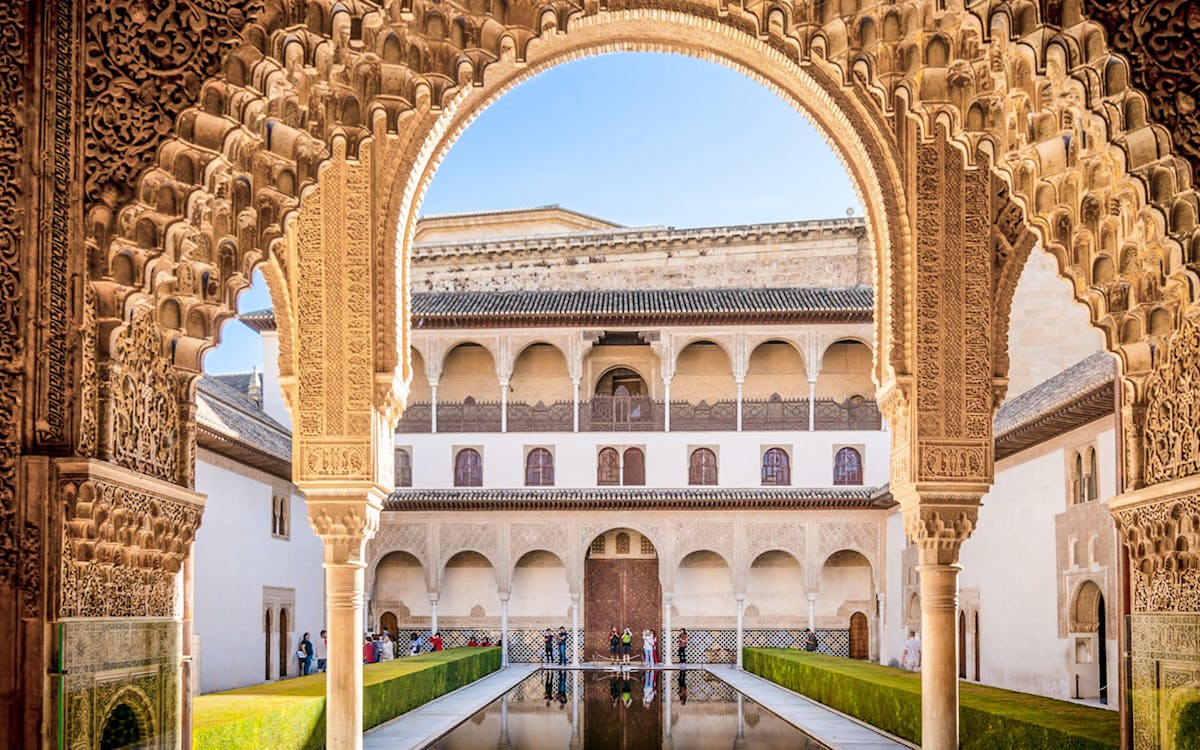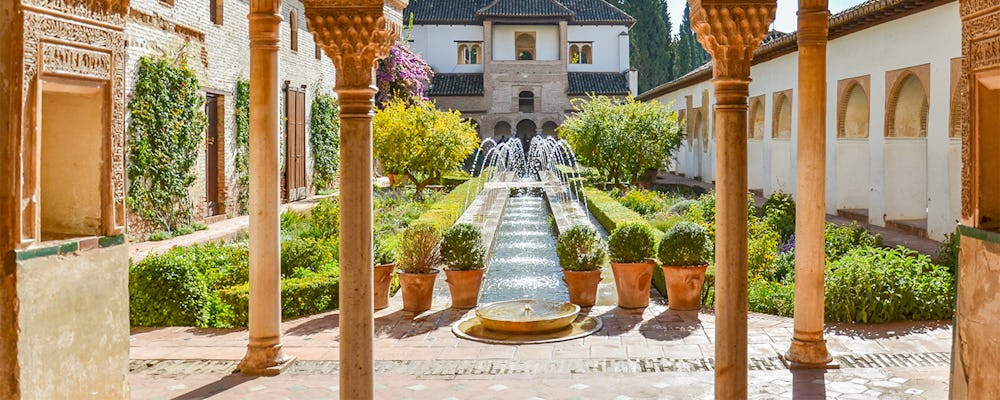To call Granada’s Alhambra anything but a historical and architectural marvel would be doing it a great disservice. The fortified palace complex that heralded the splendour of the Nasrid Emirate is packed with Moorish lore and offers glimpses of the Spanish reconquest that followed centuries later. On these fabled grounds, that loom over Granada, you’ll scale the imposing towers of the Alcazaba (citadel), be knocked over by the astounding beauty of the Nasrid Palaces that spotlight Islamic architecture, and breeze through the calming gardens of Generalife. Here are all the unmissable details of everything inside the Alhambra.
Why should you go inside Alhambra?

Visit one of Spain’s most visited monuments:
Close to 3 million visitors come to the Alhambra every year, making it the second most-visited site in Spain. And this is not without good reason! Alhambra remains one of the best-preserved pieces of Moorish history in Europe and is renowned for its architectural beauty.
To discover Spain’s fascinating Moorish history:
Between the 13th and 15th centuries, Granada remained the seat of power of the Nasrid Emirate and the Alhambra showcases this unique chapter in world history with great aplomb.
To gawk at brilliant Islamic architecture in Europe:
Sure, Alhambra is a remarkable historical site but it is equally an architectural wonder! The Nasrid rulers built up the 35 acres that make up the Alhambra to include an intimidating fortress and the Nasrid Palaces – which are adorned with unparalleled stucco, tile, wood, and vaulting work.
Admire Renaissance-era monuments after the Spanish Reconquest:
Located close to the Nasrid Palaces is the Palace of Charles V – a Renaissance-style palace built after Spain’s Christian monarchy took over Granada in the 15th century. While this is the most prominent of the Christian structures, Alhambra is dotted with bell towers, chapels and European-style gardens that highlight Granada’s chequered history.
Enjoy a moment of serenity at the expansive gardens:
Alhambra’s Islamic and Christian rulers took a keen interest in nurturing expansive gardens that added plenty of tranquillity and beauty to the monumental complex. The gardens and orchards surrounding Generalife, which sits above Alhambra, are truly a sight to behold!
For sweeping views of Granada:
Alhambra sits on a hill over the city of Granada and from the lofty heights of its towers and palace lookouts, you’ll be treated to unmatched views of Granada and its red-tiled roofs along with the Sierra Nevada mountains in the distance.
Recommended Alhambra tickets
Top highlights inside the Alhambra
Once the capital of the Nasrid emirate, Alhambra’s vast area includes a fortress, palaces and gardens. Here are the must-visits at the Alhambra.
Alcazaba

When the Nasrid era dawned on Granada in the 1200s, Muhamad I Ibn al-Ahmar, the founder of the Emirate, first set his attention to fortifying his stronghold. This makes Alhambra’s Alcazaba, the complex’s oldest, still-standing construction. Said to have been built on the remnants of pre-existing fortifications, the soaring walls and ramparts of the imposing Alcazaba (meaning, citadel in Arabic) are crafted from red, rammed earth. Enclosed in the multi-layered walls are hammams, silos, dungeons, communal kitchens, and a water supply cistern that indicate that the Alcazaba was a thriving military encampment. Today, visitors can get a feel of the Nasrid era’s imperial might and scale the length of the imposing towers, that dot the citadel, to get a bird’s eye view of Granada.
Nasrid Palaces

Alhambra’s most spectacular offering, the Nasrid Palaces are, simply put, works of art! Successive Nasrid rulers built these series of Palaces that clearly showed off the sheer brilliance of the court’s artisans as much as they showcased the majesty of the Nasrid emirate itself.
Sectioned into three parts, the Nasrid Palaces feature soaring walls and elegant arches covered in stucco work, shiny, geometrically patterned tiles, and ceilings that are covered in inspiring hand-carved wood and stonework. At the Mexuar, the council room of the Emir, the delicate, wooden ceiling would have, once upon a time, surely added elegance to proceedings as the council debated the administrative and judicial matters of the state.
In the private sections of the Nasrid Palaces, including the Palacio de Comares (Comares Palace) and the Palacio de los Leones (Palace of the Lions), the walls dazzle with endless stucco work in graceful floral and geometric motifs. However, what steals the show are the ceilings of many of the salons. At Salón de los Embajadores, you’ll surely develop a crick in your neck as you take in the cedar ceiling that’s made up of 8,000 pieces that come together to reflect the heavens. Another equally heavenly sight is the stone-carved ceiling of the Sala de los Abencerrajes – where the detailed vaulting work in the shape of a celestial star is sure to take your breath away.
Generalife

While Generalife, a serene, whitewashed summer estate of the Nasrids, stands separately above the Alhambra complex, it is part of the experience (your Alhambra ticket will usually cover Generalife too). The breezy, two-level structure’s details include a series of elegant archways that let in the warm rays of the sun and a tiled roof. Surrounding the Palace are expansive gardens and orchards that are dotted with fountains and waterways.
Palace of Charles V:

Sitting stoutly near the famed Nasrid Palaces is the Palace of Charles V – a two-tiered, square edifice built in the Renaissance style. The stone exterior is marked by arched entrances that are decorated with relief work and symmetrical Venetian windows. The square outer form opens out into a circular courtyard with neatly arranged columns. Today, the Palace houses two museums. On the lower floor is the Alhambra Museum which showcases the artefacts found at the historic complex while the upper level is occupied by the Museum of Fine Arts where the work of Spanish painters is on display.
Alhambra: Insider tips
- The Alhambra is pretty extensive so make sure you wear comfortable clothes and shoes so that you can walk around with ease. The stairways at the Alcazaba are especially steep so ensure your shoes have a good grip.
- Entry to the Nasrid Palaces is time-slotted. Missing your time slot means missing your chance to explore the Palaces. Make sure you queue up on time so that you don’t miss your slot.
- Backpacks, large bags, and strollers have to be checked in at the entrance. However, you can sign up for baby backpacks to carry infants around.
- The use of flash photography and tripods is strictly prohibited unless you have obtained authorised permission.
- There are plenty of water fountains around but food options are limited to vending machines. Make sure you have had a good meal before heading out to explore the Alhambra.
Frequently asked questions
Because the Alhambra is situated on a hill, visitors can expect spectacular views pretty much from every direction. The watchtower in Alcazaba, the windows at Nasrid Palace, and the Generalife Palace offer some of the best views.
Allow 4 hours for an unhurried visit to the Alhambra. Start early in the morning and see Nasrid Palace, followed by the Alcazaba and the Generalife.
Yes, you are allowed to bring your food. Snacks and sandwiches, as well as a small bottle of water or soft drink, are all permitted.
Washrooms are located near the stage of the modern open-air auditorium near the Generalife grounds and at the Wine Gate between the Nasrid Palace and Alcazaba.
While photography is permitted in most areas of the Alhambra Palace, selfie sticks, camera lights, and tripods are not permitted in certain areas. Please be mindful when clicking pictures.
Ready to head to Alhambra Granada?
Purchase discounted Alhambra tickets via Headout today!
Explore The Rest of Granada
Fancy heading out to some other must-visit Granada attractions? Take inspiration from our list of the best things to do in Granada here. Use our comprehensive Granada Travel Guide to explore the rest of Granada in a hassle-free fashion with all the need-to-know information in hand.

